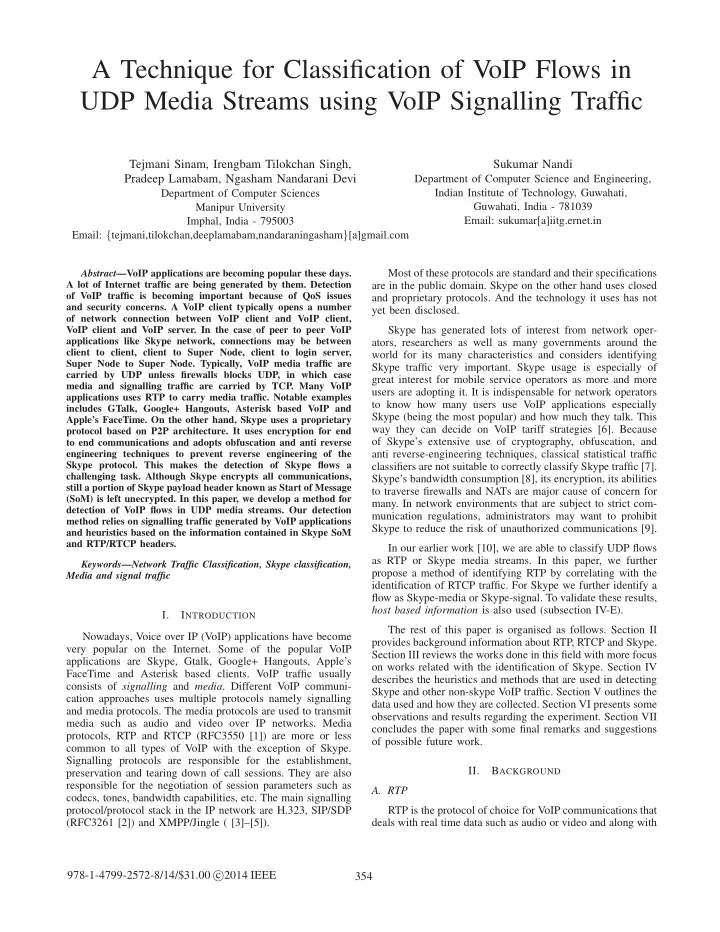

A Technique for Classification of VoIP Flows in UDP Media Streams using VoIP Signalling Traffic Tejmani Sinam, Irengbam Tilokchan Singh, Sukumar Nandi Pradeep Lamabam, Ngasham Nandarani Devi Department of Computer Science and Engineering, Department of Computer Sciences Indian Institute of Technology, Guwahati, Guwahati, India - 781039 Manipur University Email: sukumar[a]iitg.ernet.in Imphal, India - 795003 Email: { tejmani,tilokchan,deeplamabam,nandaraningasham } [a]gmail.com Abstract —VoIP applications are becoming popular these days. Most of these protocols are standard and their specifications A lot of Internet traffic are being generated by them. Detection are in the public domain. Skype on the other hand uses closed of VoIP traffic is becoming important because of QoS issues and proprietary protocols. And the technology it uses has not and security concerns. A VoIP client typically opens a number yet been disclosed. of network connection between VoIP client and VoIP client, VoIP client and VoIP server. In the case of peer to peer VoIP Skype has generated lots of interest from network oper- applications like Skype network, connections may be between ators, researchers as well as many governments around the client to client, client to Super Node, client to login server, world for its many characteristics and considers identifying Super Node to Super Node. Typically, VoIP media traffic are Skype traffic very important. Skype usage is especially of carried by UDP unless firewalls blocks UDP, in which case great interest for mobile service operators as more and more media and signalling traffic are carried by TCP. Many VoIP users are adopting it. It is indispensable for network operators applications uses RTP to carry media traffic. Notable examples to know how many users use VoIP applications especially includes GTalk, Google+ Hangouts, Asterisk based VoIP and Skype (being the most popular) and how much they talk. This Apple’s FaceTime. On the other hand, Skype uses a proprietary way they can decide on VoIP tariff strategies [6]. Because protocol based on P2P architecture. It uses encryption for end of Skype’s extensive use of cryptography, obfuscation, and to end communications and adopts obfuscation and anti reverse engineering techniques to prevent reverse engineering of the anti reverse-engineering techniques, classical statistical traffic Skype protocol. This makes the detection of Skype flows a classifiers are not suitable to correctly classify Skype traffic [7]. challenging task. Although Skype encrypts all communications, Skype’s bandwidth consumption [8], its encryption, its abilities still a portion of Skype payload header known as Start of Message to traverse firewalls and NATs are major cause of concern for (SoM) is left unecrypted. In this paper, we develop a method for many. In network environments that are subject to strict com- detection of VoIP flows in UDP media streams. Our detection munication regulations, administrators may want to prohibit method relies on signalling traffic generated by VoIP applications Skype to reduce the risk of unauthorized communications [9]. and heuristics based on the information contained in Skype SoM and RTP/RTCP headers. In our earlier work [10], we are able to classify UDP flows as RTP or Skype media streams. In this paper, we further Keywords — Network Traffic Classification, Skype classification, propose a method of identifying RTP by correlating with the Media and signal traffic identification of RTCP traffic. For Skype we further identify a flow as Skype-media or Skype-signal. To validate these results, host based information is also used (subsection IV-E). I. I NTRODUCTION The rest of this paper is organised as follows. Section II Nowadays, Voice over IP (VoIP) applications have become provides background information about RTP, RTCP and Skype. very popular on the Internet. Some of the popular VoIP Section III reviews the works done in this field with more focus applications are Skype, Gtalk, Google+ Hangouts, Apple’s on works related with the identification of Skype. Section IV FaceTime and Asterisk based clients. VoIP traffic usually describes the heuristics and methods that are used in detecting consists of signalling and media . Different VoIP communi- Skype and other non-skype VoIP traffic. Section V outlines the cation approaches uses multiple protocols namely signalling data used and how they are collected. Section VI presents some and media protocols. The media protocols are used to transmit observations and results regarding the experiment. Section VII media such as audio and video over IP networks. Media concludes the paper with some final remarks and suggestions protocols, RTP and RTCP (RFC3550 [1]) are more or less of possible future work. common to all types of VoIP with the exception of Skype. Signalling protocols are responsible for the establishment, II. B ACKGROUND preservation and tearing down of call sessions. They are also responsible for the negotiation of session parameters such as A. RTP codecs, tones, bandwidth capabilities, etc. The main signalling protocol/protocol stack in the IP network are H.323, SIP/SDP RTP is the protocol of choice for VoIP communications that (RFC3261 [2]) and XMPP/Jingle ( [3]–[5]). deals with real time data such as audio or video and along with 978-1-4799-2572-8/14/$31.00 c � 2014 IEEE 354
Recommend
More recommend